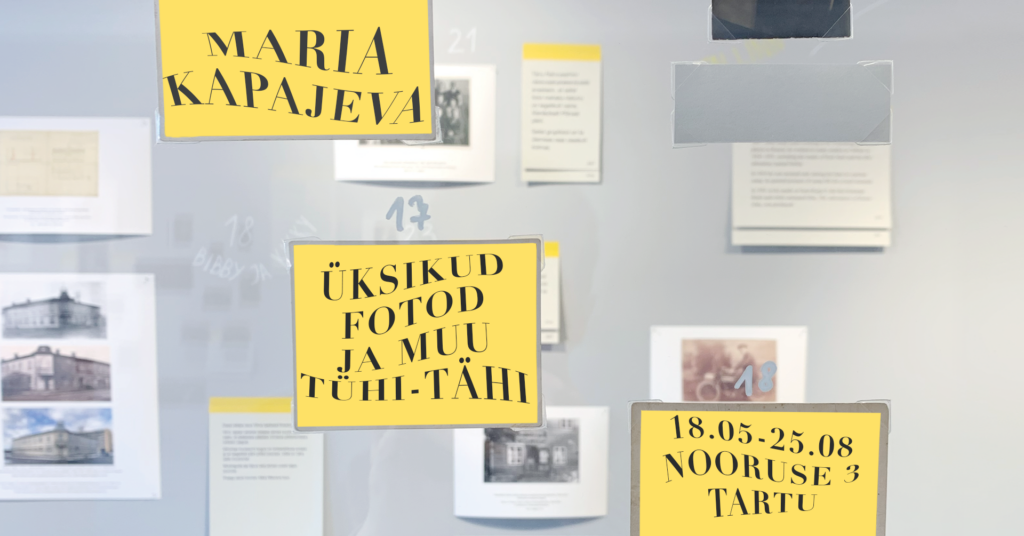Welcome to the photo exhibition by Maria Kapajeva until the end of August
On 18 May at 4 PM, artist Maria Kapajeva opens her exhibition “Loose photos, odds and ends” at the National Archives in Tartu by introducing the exhibit in English.
Eight years ago, Maria Kapajeva came across a few old photographs online for sale. “This was quite a random purchase for me. An American dealer who runs an online shop selling old images from all over the world agreed to put together ‘a collection’ of photographs, which he thought might be from Estonia. So, this is how this 105-piece collection of ‘loose photos, odds and ends’ (according to the collector’s description) ended up in my hands. In his message he added ‘I am so glad these photos are “going home”, so to speak’. I had no knowledge of the images or how they ended up in the US. At the end of 2021, when I started to prepare for this exhibition, I tried to contact the collector again, but I learned that he had unexpectedly died a week before. It was sad to realise that I had had those eight years to ask him questions, but I had not and now I could not. So, I hope with the help of visitors to the exhibition, I can get answers to some of my questions.”
The National Archives of Estonia also has in its collections many photographs where it hasn’t been possible to identify the person(s) in the picture. We can rely on the new technologies that identify people for us, and, like Kapajeva, on archive users who will send clarifications. The artist undertook a substantial research putting together this exhibition using archives’ face recognition software as well as archival records.
This exhibition is an artistic experiment: presenting a research process as an installation. Kapajeva experiments with different ways of opening up the potential of the often undervalued, under-researched and marginalised heritage of every-day photography. With this in mind, the artist introduces stories of people, photographers and their assistants who are often invisible or considered unimportant to mention. In the age of automated face recognition software – partly developed by archives, but even more so by state and military institutions and international corporations – her project demonstrates the benefits of “slow recognition”.
Gradual identification of the photographers and the people portrayed by them reveals new perspectives on Estonian (micro-)history. By focusing on the faces of the photographed people, their stories and some other forgotten facts which she learned from these images, Kapajeva shows her appreciation for each person and every individual story in our history.
Maria Kapajeva invites all visitors to contribute to the installation as a continuous research process. While visiting the exhibit, please look at the photos closely, and if you recognise anyone or have any comments you would like to add, please use the yellow paper you will find on the table to write down what you know or would like to share, and attach the paper to the wall with tape. You may write in any language you wish.
The exhibition was commissioned by Estonian Art Museum Kumu for a project space at the
permanent exhibition “Landscapes of Identity: Estonian Art 1700-1945”, curated by Linda Kaljundi
and Kadi Polli. At the National Archives in Tartu (Noorus 3), the exhibition is open from 18 May until 25 August from Monday to Friday at 9–19, since 26 June at 9–17. Visiting the exhibit is free of charge, everyone is warmly welcome!
Exhibition designer: Karolin Kull
Exhibition design concept: Laura Linsi / LLRRLLRR
Exhibition coordinator: Liisi Pabstel
Exhibition technicians: Ojari Lüüs and Peeter Reppo
Concept of the exhibition graphic design: Maria Muuk
Exhibition poster: Einike Leppik
Artist’s research assistant: Ketlin Käpp
With contribution in kind by Linda Kaljundi, Annika Toots, Karmen-Eliise Kiidron, Mirja Ots
Special thanks to Linda Kaljundi, Kadi Polli, Liisa Kaljula, Merilis Roosalu (Tallinn City Museum – Museum of Photography), Mari Škerin, Stella Mõttus, Aado Luik, Janeli Suits, Piret Karro, Lembi Anepaio, Tiia Haug, Siim Asmer, Aljona Kapajeva, the Sokk family, Jaan Joonas, Mari Jänes, Tiina and Kristiina Aarna
